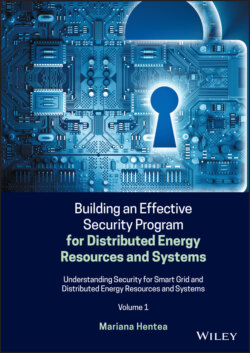Читать книгу Building an Effective Security Program for Distributed Energy Resources and Systems - Mariana Hentea - Страница 93
2.6.2 The US Plans
ОглавлениеIn the United States, the Federal Energy Regulatory Commission (FERC) defines polices for Smart Grid cybersecurity. Cybersecurity is briefly understood as encompassing measures to ensure the confidentiality, integrity, and availability of the electronic information communication systems and the control systems necessary for the management, operation, and protection of the Smart Grid's energy, IT, and telecommunication infrastructures [FERC 2009]. DOE supports the administration's strategic comprehensive approach to cybersecurity for the power grid. Also, DOE works closely with the DHS, industry, and other government agencies on an ongoing basis to reduce the risk of energy disruptions due to cyber attacks.
The DOE envisions a robust, resilient energy infrastructure in which continuity of business and services is maintained through secure and reliable information sharing, effective risk management programs, coordinated response capabilities, and trusted relationships between public and private security partners at all levels of industry and government [DOE 2010]. While the DOE cybersecurity roadmap provides a foundation for the development and adoption of interoperability and cybersecurity standards, the updated roadmap of 2011 [DOE 2011] goes on to recognize the advances in cybersecurity and other technology including the evolving needs of the energy sector such as the following:
Providing a broader focus on energy delivery systems, including control systems, Smart Grid technologies, and the interface of cyber and physical security – where physical access to system components can impact cybersecurity.
Building on successes and addressing gaps require new priorities to be identified such as enhancing vulnerability disclosure between government, researchers, and industry; addressing gaps to further advance technologies.
Advancing threat capabilities by implementing enhanced security capabilities to protect energy delivery systems against threats that are becoming increasingly innovative, complex, and sophisticated.
Emphasizing a culture of security that includes training people for developing and implementing the best available security policies, procedures, and technologies tailored to the energy delivery systems operational environment.
In its broadest sense, cybersecurity for the power industry covers all issues involving automation and communications that affect the operation of electric power systems, the functioning of the utilities that manage them, and the business processes that support the customer base.
Actions to develop the Smart Grid architecture include the coordinated advancement of standards across the electric power system, including device characteristics, communication requirements, security, and other system aspects [DOE 2015a].
Implementation of cybersecurity can occur through a variety of mechanisms, including use of standards and recommendations, enforcement of regulations, and voluntary compliance in response to business incentives. The energy sector, specifically electrical sector organizations, can use several mechanisms for designing and implementation of security and protection of energy systems. In addition, utilities, vendors, consultants, national laboratories, higher education institutions, governmental entities, and other organizations continuously contribute and participate in the standards and guidance of the electricity sector.
Also, energy systems and networks cross the national borders, making international collaboration a necessary component of the sector's efforts to develop standards to secure the energy infrastructure.
